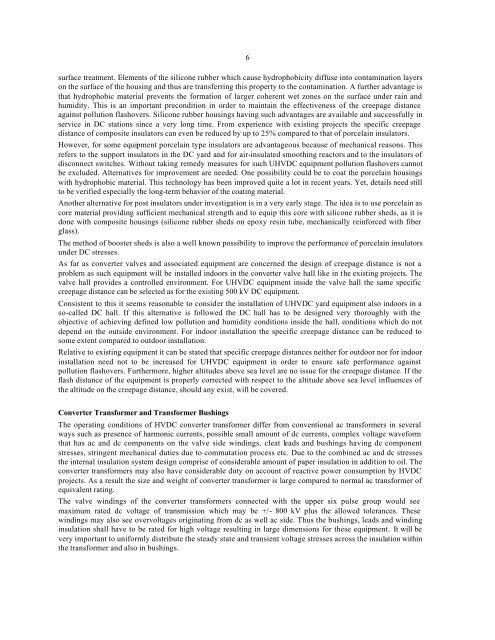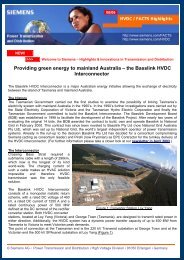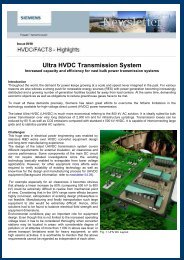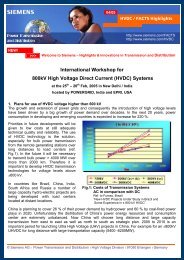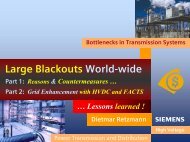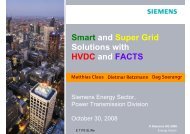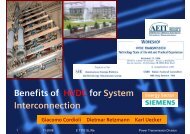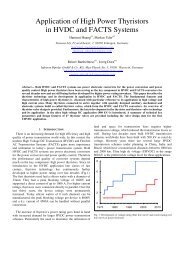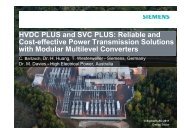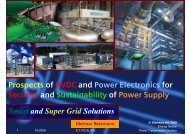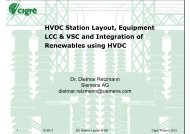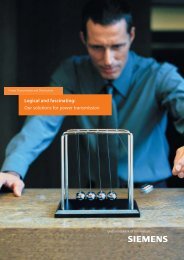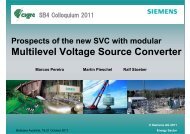Technology and Development of 800 kV HVDC ... - Siemens
Technology and Development of 800 kV HVDC ... - Siemens
Technology and Development of 800 kV HVDC ... - Siemens
Create successful ePaper yourself
Turn your PDF publications into a flip-book with our unique Google optimized e-Paper software.
6<br />
surface treatment. Elements <strong>of</strong> the silicone rubber which cause hydrophobicity diffuse into contamination layers<br />
on the surface <strong>of</strong> the housing <strong>and</strong> thus are transferring this property to the contamination. A further advantage is<br />
that hydrophobic material prevents the formation <strong>of</strong> larger coherent wet zones on the surface under rain <strong>and</strong><br />
humidity. This is an important precondition in order to maintain the effectiveness <strong>of</strong> the creepage distance<br />
against pollution flashovers. Silicone rubber housings having such advantages are available <strong>and</strong> successfully in<br />
service in DC stations since a very long time. From experience with existing projects the specific creepage<br />
distance <strong>of</strong> composite insulators can even be reduced by up to 25% compared to that <strong>of</strong> porcelain insulators.<br />
However, for some equipment porcelain type insulators are advantageous because <strong>of</strong> mechanical reasons. This<br />
refers to the support insulators in the DC yard <strong>and</strong> for air-insulated smoothing reactors <strong>and</strong> to the insulators <strong>of</strong><br />
disconnect switches. Without taking remedy measures for such U<strong>HVDC</strong> equipment pollution flashovers cannot<br />
be excluded. Alternatives for improvement are needed. One possibility could be to coat the porcelain housings<br />
with hydrophobic material. This technology has been improved quite a lot in recent years. Yet, details need still<br />
to be verified especially the long-term behavior <strong>of</strong> the coating material.<br />
Another alternative for post insulators under investigation is in a very early stage. The idea is to use porcelain as<br />
core material providing sufficient mechanical strength <strong>and</strong> to equip this core with silicone rubber sheds, as it is<br />
done with composite housings (silicone rubber sheds on epoxy resin tube, mechanically reinforced with fiber<br />
glass).<br />
The method <strong>of</strong> booster sheds is also a well known possibility to improve the performance <strong>of</strong> porcelain insulators<br />
under DC stresses.<br />
As far as converter valves <strong>and</strong> associated equipment are concerned the design <strong>of</strong> creepage distance is not a<br />
problem as such equipment will be installed indoors in the converter valve hall like in the existing projects. The<br />
valve hall provides a controlled environment. For U<strong>HVDC</strong> equipment inside the valve hall the same specific<br />
creepage distance can be selected as for the existing 500 <strong>kV</strong> DC equipment.<br />
Consistent to this it seems reasonable to consider the installation <strong>of</strong> U<strong>HVDC</strong> yard equipment also indoors in a<br />
so-called DC hall. If this alternative is followed the DC hall has to be designed very thoroughly with the<br />
objective <strong>of</strong> achieving defined low pollution <strong>and</strong> humidity conditions inside the hall, conditions which do not<br />
depend on the outside environment. For indoor installation the specific creepage distance can be reduced to<br />
some extent compared to outdoor installation.<br />
Relative to existing equipment it can be stated that specific creepage distances neither for outdoor nor for indoor<br />
installation need not to be increased for U<strong>HVDC</strong> equipment in order to ensure safe performance against<br />
pollution flashovers. Furthermore, higher altitudes above sea level are no issue for the creepage distance. If the<br />
flash distance <strong>of</strong> the equipment is properly corrected with respect to the altitude above sea level influences <strong>of</strong><br />
the altitude on the creepage distance, should any exist, will be covered.<br />
Converter Transformer <strong>and</strong> Transformer Bushings<br />
The operating conditions <strong>of</strong> <strong>HVDC</strong> converter transformer differ from conventional ac transformers in several<br />
ways such as presence <strong>of</strong> harmonic currents, possible small amount <strong>of</strong> dc currents, complex voltage waveform<br />
that has ac <strong>and</strong> dc components on the valve side windings, cleat leads <strong>and</strong> bushings having dc component<br />
stresses, stringent mechanical duties due to commutation process etc. Due to the combined ac <strong>and</strong> dc stresses<br />
the internal insulation system design comprise <strong>of</strong> considerable amount <strong>of</strong> paper insulation in addition to oil. The<br />
converter transformers may also have considerable duty on account <strong>of</strong> reactive power consumption by <strong>HVDC</strong><br />
projects. As a result the size <strong>and</strong> weight <strong>of</strong> converter transformer is large compared to normal ac transformer <strong>of</strong><br />
equivalent rating.<br />
The valve windings <strong>of</strong> the converter transformers connected with the upper six pulse group would see<br />
maximum rated dc voltage <strong>of</strong> transmission which may be +/- <strong>800</strong> <strong>kV</strong> plus the allowed tolerances. These<br />
windings may also see overvoltages originating from dc as well ac side. Thus the bushings, leads <strong>and</strong> winding<br />
insulation shall have to be rated for high voltage resulting in large dimensions for these equipment. It will be<br />
very important to uniformly distribute the steady state <strong>and</strong> transient voltage stresses across the insulation within<br />
the transformer <strong>and</strong> also in bushings.


